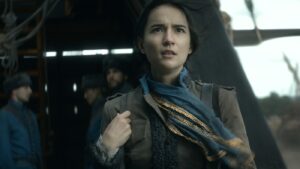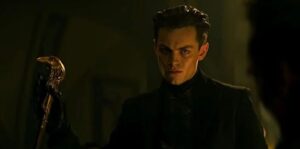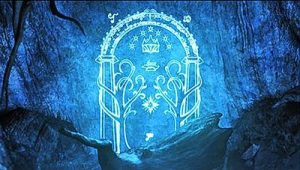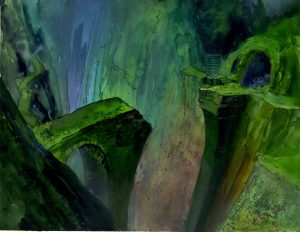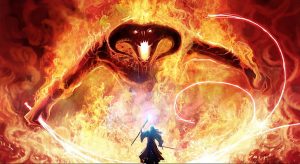SPOILERS FOR SHADOW AND BONE AHEAD!
The main selling point of Shadow And Bone for many viewers, Ben Barnes’ portrayal of The Darkling was a casting “secret” so thinly veiled – and so quickly uncovered – that it never should have been a secret in the first place. And not only because it was so obvious to book readers that even casual fans were soon made aware of The Darkling and his villainy, but because, even if I had never read Shadow And Bone nor ever heard the name, I’d still be ten times more likely to check out a new fantasy series starring Ben Barnes as a charismatic villain called The Darkling than a pretend good guy with the ridiculously bland code-name of “General Kirigan”.

The former exudes…confidence, mystery, more than a hint of sexuality. The latter just sounds flat and dull, and undersells Ben Barnes’ ability to make a character named The Darkling appear genuinely morally conflicted – which he does, brilliantly, over the course of Shadow And Bone‘s first season.
All of which is to say, nothing can convince me that the pros of preserving the once-and-done surprise of his villain turn outweigh the cons of losing the chance to extensively market Ben Barnes as a villain. But you’ll have to wait until episode two of Shadow And Bone to properly meet Barnes’ hotly-anticipated (and just plain hot) version of the controversial character, who is something of a lightning rod in the Grishaverse fandom, attracting legions of adoring fans and ardent haters who fight over him on Twitter constantly.
In just this one episode, the popular fan-ship between The Darkling and Alina Starkov (Jessie Mei Li), dubbed “Darklina” by fans, springboards effortlessly from page to screen thanks to Barnes and Mei Li’s instant chemistry – though the episode is bookended by scenes reminding us of the even stronger bond between Alina and her best friend, Mal Oretsev (Archie Renaux). Part of why Darklina is so popular still in the Grishaverse fandom is because “Malina” was so widely hated, but with Mal actually being an interesting and likable character in the Netflix adaptation, I suspect we’ll start to see an unexpected shift in ship loyalties (even though Malina work better as platonic soulmates than as lovers).
But the Darklina scenes still carry weight – particularly a sequence lifted almost word-for-word from the pages of Shadow And Bone, in which the Grisha are ambushed by Fjerdan witch-hunters from the north while racing back to the Little Palace with Alina, and The Darkling saves Alina’s life in the nick of time by using his most unique and terrifying weapon, The Cut. Best described as a bladed boomerang made of pure shadow, The Cut is capable of slicing people and objects in half; and is only used by The Darkling as a last resort when he’s been backed into a corner (something to keep in mind when he uses it later in the season).

The Cut is very clearly the most powerful weapon in the Grisha’s Second Army (besides Alina herself), but this episode also gives us a good look at the abilities of Grisha Heartrenders, one of whom we saw in the first episode using her power to gently coax information out of an uncooperative prisoner by slowing his heart-rate and loosening his inhibitions. But that was in Ketterdam, and that was a very different circumstance. Here in Ravka, the militarized Heartrenders are used more often to gruesomely stop an opponent’s heart or manipulate their bodies, always accompanied by a sickening sound of bones bending and cracking.
But Shadow And Bone also makes it clear that Grisha aren’t invincible, and that they are in fact quickly becoming obsolete in the face of new technology and weaponry being employed on the front lines by both of Ravka’s hostile neighbors, Fjerda and Shu Han. Even their bulletproof kefta can’t entirely slow down a barrage of machine-gun bullets, and the walls of their Little Palace won’t protect them forever. And that in turn lends The Darkling’s mission to protect the Grisha more urgency, as we see how any fallout from their mistakes leads to Grisha being persecuted and slaughtered worldwide. If they lose their natural advantage over human weapons, they will lose everything they’ve gained in several centuries, all their accumulated privilege and power.
Meanwhile in Ketterdam, it’s nothing quite so noble that motivates Kaz Brekker (Freddy Carter, whose eyebrow game is on point this episode) to begin assembling a team to cross the Shadow-Fold and kidnap Alina himself. He doesn’t care about the Grisha, or the Ravkan political situation – he’s in it for the prize of one-million kruge that awaits anyone who returns to Ketterdam with the Sun-Summoner. But this episode does layer in a personal level to Kaz’s mission, as he’s forced to outwit and outmaneuver his own nemesis, rival gang leader Pekka Rollins (Dean Lennox Kelly). The series never dives into the backstory between Brekker and Rollins, leaving that wealth of material for the second season to explore, but book readers will pick up on a number of hints.
The sequences in Ketterdam are already complex enough, however, with the addition of a subplot for Inej Ghafa (Amita Suman), who has to pay off an existing debt to brothel-owner Tante Heleen (Deirdre Mullins) before she can leave town, by assassinating a smuggler. A bit of double-crossing ensues, we meet a truly wonderful side-character named Poppy (Micah Holmes), who gets far too little screen-time; and Kaz is forced to intervene just before Inej can strike down her target, who turns out to be the one man who could get them through the Fold – the mysterious Conductor, Arken (Howard Charles), an original character created for the series. Charles doesn’t ever make much of an impression in the role, but the character becomes quite significant later in Shadow And Bone as his own ulterior motives are uncovered.

My biggest complaint with this episode, which is the last one in which we spend much time in Ketterdam, is that the canal city doesn’t feel as large or sprawling as it does in the books – most of the action here takes place in a variety of small, smoke-filled rooms and parlors; the city streets are very clearly a single refurbished soundstage; and there’s just one establishing shot of the entire location, at night. But this is still only an introduction to the Six Of Crows story, and I hope (and strongly believe) the whole city and its diverse cast of characters will get more screen-time in season two.
Episode Rating: 8.5/10
